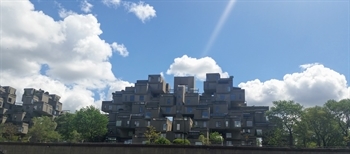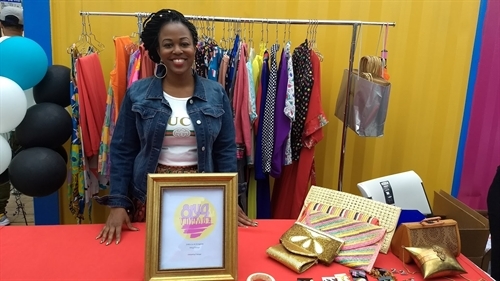
View of Montreal City Hall from the Old Port
Earlier this month, I joined a group of 75 urban thinkers for Next City’s annual Vanguard conference. Though we came from all parts of the world, from different disciplines, backgrounds and cultures, we quickly found that one commonality we all shared was a curiosity for urban places and a passion for innovating change within these spaces.
Montreal was a fitting backdrop for the conference, particularly as it is in the midst of a year-long celebration of their 375th anniversary. This was both a time of reflection and celebration for a place that prides itself as one of the oldest and most inclusive cities in North America. While Montreal has significantly upped the ante in terms of its public investments in the arts and cultural displays in observance of the anniversary, officials have been careful to acknowledge that many of the prized cultural assets that the city is known for were built on unceded indigenous land, a term I often heard. Also notable is the fact that the Mayor and other key leaders have proposed updating their city flag to reflect the Aboriginal population, in addition to the Scottish, Irish, English and French heritages which are currently included on the flag and coat of arms.
Montrealers don’t fear their neighbors. They worked to build relationships with people within their communities.
As an outsider looking in, it was remarkable that the City of Montreal capitalized on this historic milestone to strike a balance between honoring its traditions and acknowledging the challenges of their city. In this way, Montreal inspires change.
So what does this have to do with Chicago?
Montreal shares many similarities to Chicago in terms of its history, culture and challenges. Both were founded along major bodies of water that were critical to positioning them as global cities and that have, in turn, shaped the various industries that grew and thrived within each. Indigenous and immigrant populations are fundamental to both cities’ histories and the makeup of its neighborhoods and cultural foundations. Meanwhile, these same populations of color are subject to displacement and all too often live in isolated geographies with access and mobility challenges relative to healthy food, jobs, transportation and amenities. Although the intersections of race and class in Montreal aren’t nearly as intertwined and tied to extreme residential segregation in the way that they are in Chicago, as documented in the Metropolitan Planning Council's recent Cost of Segregation study, segregation is still an issue that Montrealers struggle with. As my Vanguard cohort and I travelled to and learned about different neighborhoods in Montreal, we heard a familiar tale of how parts of the city were divided by race, language and income. We also heard from people of color about their fear of displacement as a result of expanded (and needed) development and investment.
A few observations on a path forward
1. Montrealers talked easily about issues of inequality. From the elected officials we spoke with, to community residents, they highlighted the great things about their City almost in the same breath that they acknowledged some of its painful and complicated parts. I wonder if one of the things that stands in the way of Chicago truly moving the needle on some of its most entrenched inequities is the fact that so many of us shy away from discussing them openly and in a way that challenges our own thinking.

Habitat 67
2. When Montreal has intentionally built inclusion into the design of its programs, it has yielded pretty interesting results. One source of pride among Montrealers is the fact that they didn’t “ghettoize” immigrant or low-income communities. Unlike large U.S. cities, and even other Canadian cities, Montreal steered clear of the dense highrises that characterize historic public housing developments. Instead, Montreal opted to prioritize social integration of tenants. Habitat 67 is one of Montreal’s most notable experiments in affordable housing design, and today boasts some of the more sought-after and picturesque views of the city.

Cid Blanco Jr.
View from Habitat 67 overlooking the Old Port of Montreal.
More recently, Montreal’s local government also created a position for a “Homeless Protector”—a City official who works closely with social change organizations like Vont Exeko, to design places that are inclusive of the homeless. The “Homeless Protector” works with social service providers and law enforcement to better coordinate services and job training for homeless in parks and other public places. It’s worth mentioning that Montreal’s inclusionary, on-site housing requirements (which developers cannot opt out of), as well as public infrastructure investments to improve access and mobility, are key tactics underscoring efforts around inclusion.
3. People don’t lock their doors in Montreal. This solidly blew my mind. This came up in random conversation with one of the partners we met with in Montreal and I made it a point to then ask everyone else I met. I couldn’t believe that literally no one locked their doors but, even more remarkably, people looked puzzled when I asked the question and then expressed my disbelief at this phenomenon. The most important takeaway here was that Montrealers don’t fear their neighbors because they worked to build relationships with people within their communities. They placed great value on cultural spaces and shared common spaces that create spaces for people to gather, and in so doing, build these relationships. Although I don’t think anyone in Chicago will be leaving any of their doors unlocked anytime soon, I think we haven’t yet begun to scratch the surface in terms of how we can better leverage “third spaces” to bring people together in ways where we get to know and form meaningful connections in our neighborhoods. One promising example of this was the recent launch of "Boxville" in Bronzeville, which catalyzed a vacant lot adjacent to the 51st Street Green line station, using shipping containers as a platform for neighborhood retail and a community gathering space.

Margarita Williams, owner of 8ty4 Vintage, vending at the Boxville event launch.
Although Chicago surely has its unique set of challenges and opportunities, there are important lessons we can take away from our sister cities, like Montreal. As we honor the rich history of Chicago and the legacy of all of the nations of people that helped build it, we must continue to aspire to become an even greater city—a city that values and invests in inclusion and equity, one whose citizens push themselves to talk about inequality and poverty and one that supports growth within neighborhoods while preserving their character and residents. This is the city that I hope we can look back on when we Chicagoans celebrate our 200th anniversary in 2033.